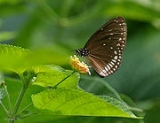
Euploea klugii
Encyclopedia
The Blue King Crow is a butterfly found in India
that belongs to the Crows and Tigers, that is, the Danaid group of the Brush-footed butterflies
family.
Typical form. Upperside: fore wing dark brown suffused up to the terinen with a brilliant blue gloss; a spot iu apex of cell, a small costal spot, two short streaks beyond apex of cell, and in the female two discal spots: in the six subterminal and terminal series of spots; in the female the latter series wanting: in both sexes the subterminal spots produced inwards. All the spots bluish white in colour. Hind wing umber-brown, the centre glossed with blue; subterminal rows of spots incomplete or obsolescent, the former reduced to two or three spots below the apex, the latter in the male mere dots; in the female absent, only seen by transparency from the underside.
_at_jayanti,_duars,_west_bengal_w_picture_200.jpg) Underside similar, paler brown, not glossed with blue; centre of fore wing dark, spots more clearly defined, subterminal and terminal series more or less complete- Antennae black; head, thorax and abdomen velvety brown, head and thorax speckled with bluish white.
Underside similar, paler brown, not glossed with blue; centre of fore wing dark, spots more clearly defined, subterminal and terminal series more or less complete- Antennae black; head, thorax and abdomen velvety brown, head and thorax speckled with bluish white.
Race kollari Upperside, very dark olive-brown, paling to lighter brown towards the termen; both wings with complete or nearly complete series of subterrninal and terminal white spots, the former larger than the latter, in the tore wing decreasing in size towards, and curving inwards opposite, the apex; in the hind wing elongate-oval, much larger than the terminal spots, these latter very regular, two in each interspace in the fore wing, obsolete towards the apex. Underside of a paler olive-brown, the spots as on upperside, with the addition m the fore wing of two to four discal spots, that in interspace two the largest, and a small costal spot; in the hind wing of one or two discal specks. Antennae very dark brown; head, thorax and abdomen dark brown, the former two speckled sparsely with white.
India
India , officially the Republic of India , is a country in South Asia. It is the seventh-largest country by geographical area, the second-most populous country with over 1.2 billion people, and the most populous democracy in the world...
that belongs to the Crows and Tigers, that is, the Danaid group of the Brush-footed butterflies
Nymphalidae
The Nymphalidae is a family of about 5,000 species of butterflies which are distributed throughout most of the world. These are usually medium sized to large butterflies. Most species have a reduced pair of forelegs and many hold their colourful wings flat when resting. They are also called...
family.
Description
Male: Forewing very variable in shape, especially in the outline of the termen and dorsum. In the type it is comparatively long in proportion to width owing to the less convexity of the dorsal margin, and has the termen oblique, slightly convex; in var. novarae it is remarkably broad, the great convexity of the dorsal margin making it almost subquadrate, while the termen is more convex than in the typical form. In the female the difference is less marked.Typical form. Upperside: fore wing dark brown suffused up to the terinen with a brilliant blue gloss; a spot iu apex of cell, a small costal spot, two short streaks beyond apex of cell, and in the female two discal spots: in the six subterminal and terminal series of spots; in the female the latter series wanting: in both sexes the subterminal spots produced inwards. All the spots bluish white in colour. Hind wing umber-brown, the centre glossed with blue; subterminal rows of spots incomplete or obsolescent, the former reduced to two or three spots below the apex, the latter in the male mere dots; in the female absent, only seen by transparency from the underside.
_at_jayanti,_duars,_west_bengal_w_picture_200.jpg)
Race kollari Upperside, very dark olive-brown, paling to lighter brown towards the termen; both wings with complete or nearly complete series of subterrninal and terminal white spots, the former larger than the latter, in the tore wing decreasing in size towards, and curving inwards opposite, the apex; in the hind wing elongate-oval, much larger than the terminal spots, these latter very regular, two in each interspace in the fore wing, obsolete towards the apex. Underside of a paler olive-brown, the spots as on upperside, with the addition m the fore wing of two to four discal spots, that in interspace two the largest, and a small costal spot; in the hind wing of one or two discal specks. Antennae very dark brown; head, thorax and abdomen dark brown, the former two speckled sparsely with white.
See also
- Danainae
- NymphalidaeNymphalidaeThe Nymphalidae is a family of about 5,000 species of butterflies which are distributed throughout most of the world. These are usually medium sized to large butterflies. Most species have a reduced pair of forelegs and many hold their colourful wings flat when resting. They are also called...
- List of butterflies of India
- List of butterflies of India (Nymphalidae)

